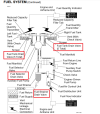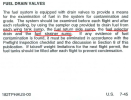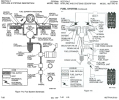Ahhh…that is where the extra drain valve comes into the picture. Thanks182S has 12.
182T has 13.
You are using an out of date browser. It may not display this or other websites correctly.
You should upgrade or use an alternative browser.
You should upgrade or use an alternative browser.
"He was such a good pilot..."
- Thread starter Dan Thomas
- Start date
Dan Thomas
Touchdown! Greaser!
- Joined
- Jun 16, 2008
- Messages
- 11,442
- Display Name
Display name:
Dan Thomas
exncsurfer
Pattern Altitude
They should have given the engineer that designed this an additional requirement: you must be slapped in the face once for every required sump point checked by every pilot who uses this every time they use it.Those were necessary to get every low point that could catch water. Those airplanes don't have the separate fuel tank like the legacy airplanes; the tanks are just sealed-off sections of the wing, the old tank bays, and structural members across the bottom of the tank can catch water and hold it until the airplane bounces around some, dislodging the water and sending it toward the outlets.
This is the bottom skin of the wing in the tank area.
View attachment 122815
Numerous drains, both inboard and outboard, due to those stiffeners and to the fact that too many pilots will sump with the airplane parked on a sideways slope.
There's one in the bottom of the header tank (reservoir), too. On the belly.
Maybe they would have designed it better. I'd rather be slapped twice than 13 times. (per flight taken)
That fuel system diagram is near identical to my 182-S, 12 drains/sumps.
I don’t think that the sumping process is onerous with 12 points. Ten of them are right at eye level and only one req that I stoop low and reach under the belly. I rest assured that I have checked all the reasonable locations where water may pool. Count me in the minority that is ok with the numerous sump points.They should have given the engineer that designed this an additional requirement: you must be slapped in the face once for every required sump point checked by every pilot who uses this every time they use it.
Maybe they would have designed it better. I'd rather be slapped twice than 13 times. (per flight taken)
Dan Thomas
Touchdown! Greaser!
- Joined
- Jun 16, 2008
- Messages
- 11,442
- Display Name
Display name:
Dan Thomas
1. Be glad it's not a low-wing airplane.They should have given the engineer that designed this an additional requirement: you must be slapped in the face once for every required sump point checked by every pilot who uses this every time they use it.
Maybe they would have designed it better. I'd rather be slapped twice than 13 times. (per flight taken)
2. Designing it to have an unobstructed bottom would cost some capacity and make tank or wing skin repairs more difficult, and add a seam all the way around the periphery, which is more places to leak. It would make bottom access covers complicated or impossible.
3. It still would not prevent water accumulating at the outboard ends of the tanks on a side slope, nor at the front on a downslope or with a flat strut or low nose tire pressure. Too many people seem ignorant of this stuff.
Water would much less of a problem if fuel vendors used water-stop filters and if owners maintained the fuel caps so that rainwater and snowmelt were kept out.
The football dude in the left seat had 9,000 hours…But was McSpadden controlling the airplane? He was in the right seat and the plan was the owner in the left seat would fly the take off and climb, and McSpadden would take the controls when they began the photography. So we don't really know who was at the controls when the return was attempted.
Aside from my father’s CFI who died (and took an entire family with him) running out of fuel on final at night over the mountains, I have to say my grand prize winner was the DPE who died scud-running on his way home from giving a PPL exam at our field. Dan something, heading back to Glens Falls, NY about 20 years ago. Flew a Cherokee wings-level into the side of a mountain 10 miles from his home field.I have to say, its those accidents with the "good" pilots that always gives me pause. One just for example, the recent Cardinal crash with Richard McSpadden. By all accounts, McSpadden was a highly accomplished and experienced aviator, yet he was put in a situation that he didn't escape. When that happens, it often makes me question my abilities and my choices. There have been numerous other examples that have triggered this reaction in me.
Its a lot easier to hear about the "dumb" pilot out doing "stupid" pilot things. Things that I would like to think I have the smarts and experience to avoid, although I know I've done some dumb stuff in the past and luckily lived to tell the tale.
Dan Thomas
Touchdown! Greaser!
- Joined
- Jun 16, 2008
- Messages
- 11,442
- Display Name
Display name:
Dan Thomas
That may well be, but the POH diagram does not show a 13th drain valve anywhere. It should be there, for legal reasons. Something is wrong here.
So where is the "fuel return side sump?" Is that part of the fuel selector valve, which directs returned fuel to the tank it came from? Or is that referring to some late-model 182T that has the header tank under the floor on the copilot's side? In the 172S, the fuel return goes to that header tank and there's a sump drain for it, for 13 total.
A look at the 172SP's system is instructive.
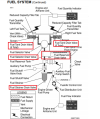
That thing labeled "Fuel Reservoir" is the header, and fuel is returned to it. The selector doesn't need to be a super-expensive ganged thing with this system. The one drawback with the header is that it's downstream of the selector, and so the selector has no shutoff function. That is a separate valve in the line just before the strainer. If the selector could shut the fuel off, it would be possible to start the airplane and take off on the gallon or so of fuel in it before the engine quit. This was a flaw with the earlier Air Plains conversions that put Continental injected engines into carbed airplanes. Injected Continentals need that header for return, to eliminate any bubbles in the fuel. Their fuel pump design has a habit of aerating the fuel. Bubbles don't burn too well. The Lyc-powered 172s also had some problems with brief engine stoppages when air got into the system when tanks unported in uncoordinated flight with low tanks, so a Service Bulletin and Service Kit was issued to install that header into earlier models.
Good question. I just remember probing 13 drains on a 2005 182T and then a few weeks later scratching my head and spending a few minutes hunting for #13 on a 182S.So where is the "fuel return side sump?" Is that part of the fuel selector valve, which directs returned fuel to the tank it came from? Or is that referring to some late-model 182T that has the header tank under the floor on the copilot's side?
Next time I'm at the airport, I'll have to take a few belly pictures. I was planning to fly yesterday, but looks like a mild head cold is delaying that to tomorrow or Monday.
Terry M - 3CK (Chicago)
Line Up and Wait
@Sierra_Hotel you teach students to reach in and pull on the magnetos and spark plug wires?Isn't that kind of the entire point of this thread? Teaching proper practices is one thing, but keeping up those practices on your own when you're not in the presence of an instructor is altogether different. Every one of the students at the school I was teaching at was taught a proper preflight and shown things above and beyond the checklist. Whether they keep that up once they're out of our hands is on them.
@Chip Sylverne I’ve never seen anyone do that in Cherokee’s, warriors or Cessnas.
Embarrassed to say I’m not sure I could find the magnetos. But I do pretty much do my pre flight exactly as taught. 30 years l later. Pretty much the same.
And generally taught the same across schools at 4 airports and 8 schools across that time.
That’s the stuff I’d love to know, though. What can really / most likely bite me.
Last edited:
Chip Sylverne
Final Approach
- Joined
- Jun 17, 2006
- Messages
- 6,042
- Display Name
Display name:
Quit with the negative waves, man.
@Sierra_Hotel you teach students to reach in and pull on the magnetos and spark plug wires?
@Chip Sylverne I’ve never seen anyone do that in Cherokee’s, warriors or Cessnas.
Embarrassed to say I’m not sure I could find the magnetos. But I do pretty much do my pre flight exactly as taught. 30 years l later. Pretty much the same.
And generally taught the same across schools at 4 airports and 8 schools across that time.
That’s the stuff I’d love to know, though. What can really / most likely bite me.
If you can pop the cowling, not only can you give a mag a little twist to see if it's loose, you can run your hand underneath it to see if the bottom is venting oil from a leaky shaft seal. Found that once too.
Good idea to have someone show you where they are.
As promised @Dan Thomas , here are a few belly shots (the non-alcoholic kind).
182S (2 sumps):
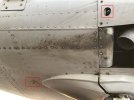
182T (3 sumps):
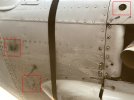
172S (3 sumps):
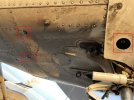
182S (2 sumps):

182T (3 sumps):

172S (3 sumps):

Sierra_Hotel
Cleared for Takeoff
- Joined
- Oct 30, 2019
- Messages
- 1,143
- Display Name
Display name:
Sierra_Hotel
Nope, and that was the point I was getting at, going that far is well beyond a normal preflight for almost any plane, but especially ones where to do so would require removing a cowling. That's not a preflight, that's maintenance. But having a flashlight and looking around in the cowling, definitely.@Sierra_Hotel you teach students to reach in and pull on the magnetos and spark plug wires?
Steamflyer
Line Up and Wait
- Joined
- Mar 23, 2022
- Messages
- 537
- Display Name
Display name:
Steamflyer
T182T absolutely has 13 sumps. Counted once.

